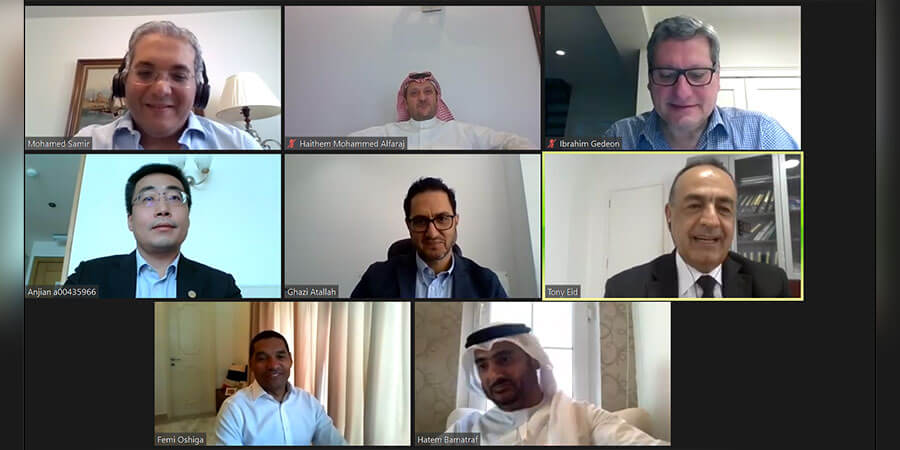The first part of the panel highlighted the causes of delay in 5G deployment and the consequences on the industry, namely on operators and vendors. Toni Eid, Founder of Telecom Review and CEO of Trace Media, who was the panel’s moderator, steered the conversation to know all of the panelists’ opinion.
The discussion kicked off with Hatem Bamatraf, CTO, Etisalat who explained more about what happened during the pandemic.
“Telecommunications is one of the sectors that have been impacted by the pandemic but probably not as badly as other sectors. We noticed a slowdown in the supply chain from the part of vendors, especially in terms of supplying equipment and executing projects. We also noticed that voice has declined in a noticeable way, data however, has grown.”
Etisalat’s CTO emphasized that 5G is a technology that will interest the enterprise sector rather than the consumer sector and will create new revenue streams.
Dr. Ibrahim Gedeon, CTO TELUS echoed that statement by Hatem Bamatarf and agreed that 5G made a great difference compared to 4G speeds, which is what enterprises are leveraging to build the use cases. As for the impact of COVID-19 on 5G, Dr. Gedeon said that “we’re all getting used to a new way of working. However, I don’t think the pandemic has slowed down the roll out of 5G, but has only put a stress on the current network. COVID-19 might have caused delays but not a material one.”
Haithem Mohammed Alfaraj, Senior VP of Technology and Operations Unit, stc stated that the delay happened mainly at the level of the equipment and logistics supply chains. Some of the challenges were the interruptions that affected the aviation industry and customs’ activity, in addition to limitations to the deployments on the field due to lockdown measures. One of the main elements of 5G that was impacted by COVID-19 was standardization, according to AlFaraj.
“Amid the economic challenges, telcos will have to review their priorities in light of the increase in data traffic and rethink how to deliver a good customer experience”, he added.
From a vendor’s point view, An Jian, President of Carrier Business Group, Huawei Middle East Region said that the pandemic has brought uncertainty to the business development. Countries had to reduce the pace of 5G deployments. However, 5G was the best option in these times.
“During COVID-19, a huge amount of data traffic was generated at home. 5G was the best option to ease network pressure. The slowdown in 5G deployment has affected the network capacity and coverage in some areas.”
However, Huawei’s An Jian believes that 5G was not the only option during the pandemic. “In KSA and the UAE, fiber investment ensured that operators can ensure high bandwidth and reliable broadband.”
“This delay is temporary. Countries will soon work on upgrading their ICT infrastructure in order to restart the economy”, he concluded.
According to Femi Oshiga, VP, Service Providers, MEA, CommScope, this is a temporary setback.
“If you think of 5G as an improvement in efficiency, whether in the efficient use of spectrum, ease of installation, optimization, whatever investment made now doesn’t go to waste. Specific spend on 5G radio, 5G core and 5G equipment, there’s been a slowdown, but in terms of improving efficiency, we believe that it’s a short and temporary setback.”
Femi Oshiga assured that this setback might not be such a bad thing. “It has in fact highlighted where there’s demand in the network, and where there is capacity requirement, latency reduction requirement and a need for reliability.”
“This delay will give us time to rethink 5G use cases monetization and an opportunity to reduce the costs of 5G devices. As CommScope, we’re seeing that operators are starting to rethink their partnerships. Some companies have been able to differentiate themselves in terms of supply chain and diversification.”
Mohamed Samir, VP of Global Services for Middle East and Africa, Nokia went back to the fact that the pandemic has indeed increased data traffic.
“Due to COVID-19, we’ve seen an increase of about 35% in mobile data traffic, and even higher increase in fixed broadband traffic. In the past, this much of increase used to be registered in one year. We’ve also seen a change in subscribers’ consumption pattern. That is why, the priority for operators and vendors in the short term was to secure the network performance and to cope with the increased demand for network capacity.”
Instead of calling it a delay in 5G deployment, Mohamed Samir chose to describe it as a short term change of priority. “The priority has been to secure and scale networks, but it doesn’t mean that operators and vendors will not work on the stimulation part to support the economy in the post-COVID-19 era through 5G.”
“As a telecom industry, we did very well in supporting the society especially at a time when everyone had to work from home”, he concluded.
Ghazi Atallah, CEO, NXN agreed with all what was said in terms in the fact that operators had to review their priorities to cope with the increase of demand on connectivity and collaboration cloud. He also pointed out how digitization was put under the spotlight.
“The acceleration of digitization and what 5G will add in this field will be quite important over the next 12 to 18 months. Not only do we need to work remotely, but we need to accomplish business processes remotely. 5G will play an important role in telehealth and video applications especially that we’ve experienced now the need for a real time experience in these fields.”









